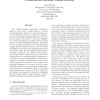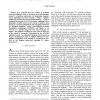160 search results - page 1 / 32 » A Computability Perspective on Self-Modifying Programs |
SEFM
2009
IEEE
13 years 11 months ago
2009
IEEE
Abstract—In order to increase their stealth, malware commonly use the self-modification property of programs. By doing so, programs can hide their real code so that it is diffi...
ACSAC
2005
IEEE
13 years 10 months ago
2005
IEEE
Recent research has proposed self-checksumming as a method by which a program can detect any possibly malicious modification to its code. Wurster et al. developed an attack again...
WCRE
2010
IEEE
13 years 2 months ago
2010
IEEE
—An important application of binary-level reverse engineering is in reconstructing the internal logic of computer malware. Most malware code is distributed in encrypted (or “pa...
FPL
1998
Springer
13 years 8 months ago
1998
Springer
The readily available performance advantages, gained in early virtual circuitry systems, are being recouped following advances in general purpose processor architectures and have ...
IJCNN
2006
IEEE
13 years 10 months ago
2006
IEEE
—It is proposed that the creation of Artificial General Intelligence (AGI) at the human level and ultimately beyond is a problem addressable via integrating computer science algo...


